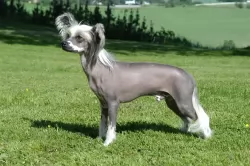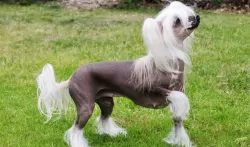 MyDogBreeds
MyDogBreedsCypro Kukur is originated from India but Chinese Crested Dog is originated from Mexico. Cypro Kukur may grow 60 cm / 24 inches higher than Chinese Crested Dog. Cypro Kukur may weigh 85 kg / 188 pounds more than Chinese Crested Dog. Both Cypro Kukur and Chinese Crested Dog has almost same life span. Both Cypro Kukur and Chinese Crested Dog has almost same litter size. Both Cypro Kukur and Chinese Crested Dog requires Low maintenance.
The Cypro Kukur is an ancient dog breed which originated in the Kumaon area of India. It is interesting to note that the name Cypro Kukur translates to Cyprus Dog, but the dog doesn’t appear to have originated in Cyprus.
The dog was used to guard livestock. It has a history that goes right back to about 300 years BC. The true history of this dog is shrouded in mystery and there are researchers who believe that foreign explorers to the Cyprus region imported these Kumaon watchdogs. There are those who believe the dog descended from the Molosser dog breeds.
The dog is also known as the Indian Mastiff or Kumaon Mastiff, but it is facing extinction with just a small number of pure Cypro Kukur remaining in the area. Today, however, there appears to be quite a large number of the dogs in Europe.
 The Chinese Crested Dog is believed to have its origins in Africa and there are many texts from the 19th Century that feature an Africa Hairless Terrier that resembles the Chinese Crested. However, the scientific and genetic evidence leads to an origin that is shared with the Mexican Hairless Dog. Any way you look at it the dog did not originate in China. The Chinese were very fond of this breed and used them on their ships to control the rat populations. This is probably how they got their name.
The Chinese Crested Dog is believed to have its origins in Africa and there are many texts from the 19th Century that feature an Africa Hairless Terrier that resembles the Chinese Crested. However, the scientific and genetic evidence leads to an origin that is shared with the Mexican Hairless Dog. Any way you look at it the dog did not originate in China. The Chinese were very fond of this breed and used them on their ships to control the rat populations. This is probably how they got their name.
There are two types of Chinese Crested Dogs – the well known Hairless, and the lesser known Powderpuff. The Hairless type is better known because they carry the dominant trait and the Powderpuff is recessive. However, this recessive gene is carried by every Chinese Crested Dog so the Powderpuff can show up in all litters even those of two Hairless Crested. Two Powderpuffs will not result in any Hairless in their litters as the Powderpuff does not have the gene for the Hairless.
The “Crest Haven” Kennel was opened by Debora Wood in the 1950’s to breed the Chines Crested Dog. At the same time Gypsy Rose Lee, of the famous burlesque shows, was also breeding Chinese Crested Dogs. The two lines of Crested bred by Americans came together following the death of Rose Lee. Every Chinese Crested that lives today can trace their heritage directly to these two breeding lines. In 1959, Debra Wood founded the American Hairless Dog Club which became a part of the American Chinese Crested Club or the ACCC in 1978. This organization then became the breed’s parent club after AKC (American Kennel Club) recognized the breed in 1991. Prior to this the Federation Cynologique Internationale, recognized the breed in 1987, the United Kingdom (UK)the Kennel Club recognized them in 1981 and the Australian National Kennel Council recognized the Crested in 1995.
The Cypro kukur is a large dog standing at anything from 70 – 90 cm and also weighing in the region of 70 – 90kg. He has an attractively lean, muscled body. He has a large head with a strong neck and floppy ears. The tail is long. The short, thick coat is a light fawn color with brindle markings or he can be white with black marking.
The Cypro Kukur is an aggressive dog breed and that is why he was used to guard livestock to ward off wild animals. He makes an excellent guard dog. However with training and socialization he makes an excellent family pet, becoming friendly and obedient around other pets and people.
 This is a toy breed and very small. The Hairless and the Powderpuff are two types of the same breed, although they do not look like it. The Hairless type can have fur anywhere on its body, but it will not have much. It will have hair on its paws, tail and head. The Powderpuff on the other hand will have a thick double coat. When discussing the color of the hairless, one is referring to the color of its skin. It can range from flesh to black.
This is a toy breed and very small. The Hairless and the Powderpuff are two types of the same breed, although they do not look like it. The Hairless type can have fur anywhere on its body, but it will not have much. It will have hair on its paws, tail and head. The Powderpuff on the other hand will have a thick double coat. When discussing the color of the hairless, one is referring to the color of its skin. It can range from flesh to black.
The Powderpuff has a soft, thick, straight double coat. It can have very long hair. The Hairless must have its skin taken care of and protected. Both types of Chines Crested are small in stature with well proportioned, athletic bodies.
The large Cypro Kukur is a fairly aggressive dog who makes for an excellent guard- or watch dog. It is important to have this dog trained and socialized as he can be aggressive.
He may be large and intimidating to look at with some aggressive tendencies, but with training they can become domesticated and then he has the capability of becoming quiet, well behaved and obedient.
If you’re looking for a large, loyal friend, then choose the Cypro Kukur, as with socialization he can make a good and loyal family pet.
 The Chines Crested Dog is very intelligent and love to perform for audiences. They do well with obedience courses and they are very affectionate lap dogs. They want to be with you and on you or in your arms all the time. They are loyal and playful.
The Chines Crested Dog is very intelligent and love to perform for audiences. They do well with obedience courses and they are very affectionate lap dogs. They want to be with you and on you or in your arms all the time. They are loyal and playful.
The Cypro Kukur can live to be 10 – 12, but he is a large dog and there will be some health concerns that your dog may never develop but are worth knowing about. These are Hip Dysplasia and Gastric Torsion.
Hip dysplasia is one of the most commonly occurring conditions that dogs have to contend with so it is worth knowing about.
It is an hereditary disease that progressively gets worse with age. Your dog can be uncomfortable and in pain. Canine hip dysplasia is when the head of the femur bone doesn’t fit properly into the hip socket. Veterinarians tell us that most dogs are actually born with normal hip joints, but that gradual subluxation brings about the development of abnormally shaped hip joints.
Gastric dilatation volvulus is another name for gastric torsion, a medical condition also referred to as a twisted stomach.
Excess gas causes what is known as bloat and its a life-threatening condition that will require immediate attention from your vet.
You’ll notice your pet’s stomach is swollen, your dog will have difficulty with breathing and he may be vomiting. It is a disease brought on by a number of factors.
 The Chinese Crested Hairless version must have its skin take care of much in the same way we take care of our own. It will burn if exposed to too much sun without protection. They can suffer from dry skin, acne, need moisturizing cremes. They get skin allergies as well and it is important to take care of the skin instead of the brushing you don’t have to do.
The Chinese Crested Hairless version must have its skin take care of much in the same way we take care of our own. It will burn if exposed to too much sun without protection. They can suffer from dry skin, acne, need moisturizing cremes. They get skin allergies as well and it is important to take care of the skin instead of the brushing you don’t have to do.
The Chinese Crested does not suffer from most of the diseases other toy breeds do. They can have ye issues. The Hairless have a “primitive mouth” . They have pointy teeth and poor dentition. This is not true of the Powderpuffs however. Their eye issues include:
This is a large dog and he will require an adequate amount of exercise. He is the kind of dog that isn’t recommended for couch potatoes. He will need to join you in your walks every day, or you can allow him to join you with your jogging or cycling.
The short coat of this large dog is easy to care for. He is a moderate shedder so a good brush twice a week will be all he needs to remove loose hairs and keep his coat healthy and shiny. Brushing him gives you the chance to check him for fleas and ticks too.
Other grooming for the Cypro Kukur should include trimming his nails and brushing his teeth twice a week with canine-approved toothbrush and toothpaste. Make a point of checking inside his ears as dogs with floppy ears are prone towards ear infections.
 Like several other toy breeds, it is easy to overfeed the Chinese Crested because it has such a small stature. Feed once or twice a day but never more than one fourth of a cup total for the day.
Like several other toy breeds, it is easy to overfeed the Chinese Crested because it has such a small stature. Feed once or twice a day but never more than one fourth of a cup total for the day.
Luxating Patellas – kneecaps move out of place and cause lameness and arthritis
Legg-Perthes Disease – a hip disorder where blood does not reach the head of the femur. The bone dies, and growth stops.
Canine Multiple System Degeneration (CMSD) – a progressive movement disorder can call falls
This Breed does not need an excessive amount of exercise, but they do enjoy running. They are competitive and athletic, so they can excel at flyball, lure coursing, agility and obedience. They are sensitive and trainable enough to become a therapy dog.